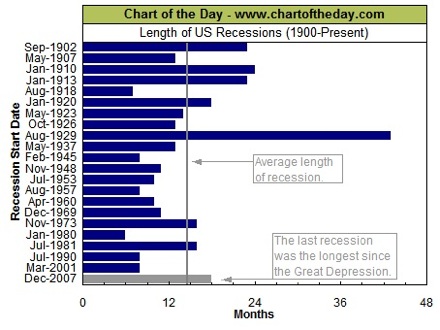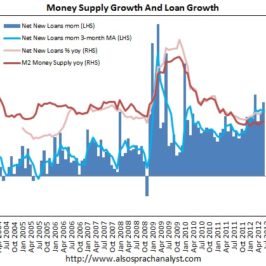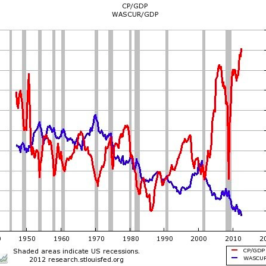Duraciones de todas las recesiones en USA y su media, desde 1900 hasta 2010 (fuente: NBER vía chartoftheday).
Esta misma semana el National Bureau of Economic Research (NBER) ha dado por finalizada estadísticamente la recesión que técnicamente se inició en diciembre 2007. Según el NBER, finalizó exactamente en junio 2009. Aquí tenéis la explicación porque no se confirma oficialmente hasta septiembre 2010 y en base a que indicadores toma su decisión:
The committee waited to make its decision until revisions in the National Income and Product Accounts, released on July 30 and August 27, 2010, clarified the 2009 time path of the two broadest measures of economic activity, real Gross Domestic Product (real GDP) and real Gross Domestic Income (real GDI). The committee noted that in the most recent data, for the second quarter of 2010, the average of real GDP and real GDI was 3.1 percent above its low in the second quarter of 2009 but remained 1.3 percent below the previous peak which was reached in the fourth quarter of 2007.
The committee concluded that the behavior of the quarterly series for real GDP and GDI indicates that the trough occurred in mid-2009. Real GDP reached its low point in the second quarter of 2009, while the value of real GDI was essentially identical in the second and third quarters of 2009. The average of real GDP and real GDI reached its low point in the second quarter of 2009. The committee concluded that strong growth in both real GDP and real GDI in the fourth quarter of 2009 ruled out the possibility that the trough occurred later than the third quarter.
The committee designated June as the month of the trough based on several monthly indicators. The trough dates for these indicators are:
Macroeconomic Advisers’ monthly GDP (June)
The Stock-Watson index of monthly GDP (June)
Their index of monthly GDI (July)
An average of their two indexes of monthly GDP and GDI (June)
Real manufacturing and trade sales (June)
Index of Industrial Production (June)
Real personal income less transfers (October)
Aggregate hours of work in the total economy (October)
Payroll survey employment (December)
Household survey employment (December)
De las 22 recesiones ocurridas en los 110 últimos años en USA, la actual recesión ha sido la quinta mayor, aunque solo esté ligeramente por encima de la media. La largísima recesión de la depresión de los años 30 supongo que sube mucho la media. Esta recesión ha sido también la mayor en los Estados Unidos desde la de 1929.
Me gustaría encontrar un análisis de si en alguna otra recesión el estado se endeudó e inyectó tanto dinero, en términos del PNB, como en esta, yo lo dudo, si realmente fuese así, esta crisis en realidad seria en cierta forma similar a la de los años 30.
De hecho este aumento del endeudamiento publico, sin duda contribuirá a disminuir el crecimiento económico en los próximos 10 años.
No olvidéis finalmente que las recesiones son trimestres continuados (al menos dos) de crecimiento negativo en el PNB o PIB, y que ahora los USA hallan consigo algunos trimestres positivos no impide que en los próximos trimestres caigan otra vez en una nueva recesión, que históricamente muy pocas veces se ha producido pero esta vez las probabilidades son mucho mayores del llamado “double dip”.
Mas en http://twitter.com/investorsconund
Para seguir las inversiones y cambios en la cartera de Koala capital sicav, sigue http://twitter.com/KOALASICAV






Oficialmente finalizada la mayor recesión desde los años 30 | Top Bilbao
[…] post: Oficialmente finalizada la mayor recesión desde los años 30 Puesto por on Sep 25th, 2010 bajo Economía. Puede serguir las respuestas de este articulo RSS […]
Mister
Esto solo tiene que ver con las elecciones americanas, no le demos más vueltas de las que realmente tiene.
Pau A. Monserrat
molt interessant. As usual
pedro gonzalez
La recesión ha acabado pero esta,como la de Bush, será a jobless recovery and a very long one.
El malestar en Estados Unidos es profundo y no mejora.
Marc Garrigasait
Maty no me funciona bien en el wordpress ni el Blockquote que me comentabas, ni el tachado (strikethrought), sabes a que puede ser debido?
La semana en los blogs XCVI
[…] empieza a dar por finalizada en algunas estadísticas, o al menos la recesión en Estados Unidos. Investors Conundrum se plantea el problema que puede tener en el crecimiento futuro el endeudamiento que se ha asumido […]